|
Supplementary code for the Build a Large Language Model From Scratch book by Sebastian Raschka Code repository: https://github.com/rasbt/LLMs-from-scratch |

|
Chapter 6: Finetuning for Text Classification#
from importlib.metadata import version
pkgs = ["matplotlib", # Plotting library
"numpy", # PyTorch & TensorFlow dependency
"tiktoken", # Tokenizer
"torch", # Deep learning library
"tensorflow", # For OpenAI's pretrained weights
"pandas" # Dataset loading
]
for p in pkgs:
print(f"{p} version: {version(p)}")
---------------------------------------------------------------------------
PackageNotFoundError Traceback (most recent call last)
Cell In[1], line 11
3 pkgs = ["matplotlib", # Plotting library
4 "numpy", # PyTorch & TensorFlow dependency
5 "tiktoken", # Tokenizer
(...)
8 "pandas" # Dataset loading
9 ]
10 for p in pkgs:
---> 11 print(f"{p} version: {version(p)}")
File /Library/Frameworks/Python.framework/Versions/3.10/lib/python3.10/importlib/metadata/__init__.py:946, in version(distribution_name)
939 def version(distribution_name):
940 """Get the version string for the named package.
941
942 :param distribution_name: The name of the distribution package to query.
943 :return: The version string for the package as defined in the package's
944 "Version" metadata key.
945 """
--> 946 return distribution(distribution_name).version
File /Library/Frameworks/Python.framework/Versions/3.10/lib/python3.10/importlib/metadata/__init__.py:919, in distribution(distribution_name)
913 def distribution(distribution_name):
914 """Get the ``Distribution`` instance for the named package.
915
916 :param distribution_name: The name of the distribution package as a string.
917 :return: A ``Distribution`` instance (or subclass thereof).
918 """
--> 919 return Distribution.from_name(distribution_name)
File /Library/Frameworks/Python.framework/Versions/3.10/lib/python3.10/importlib/metadata/__init__.py:518, in Distribution.from_name(cls, name)
516 return dist
517 else:
--> 518 raise PackageNotFoundError(name)
PackageNotFoundError: No package metadata was found for matplotlib
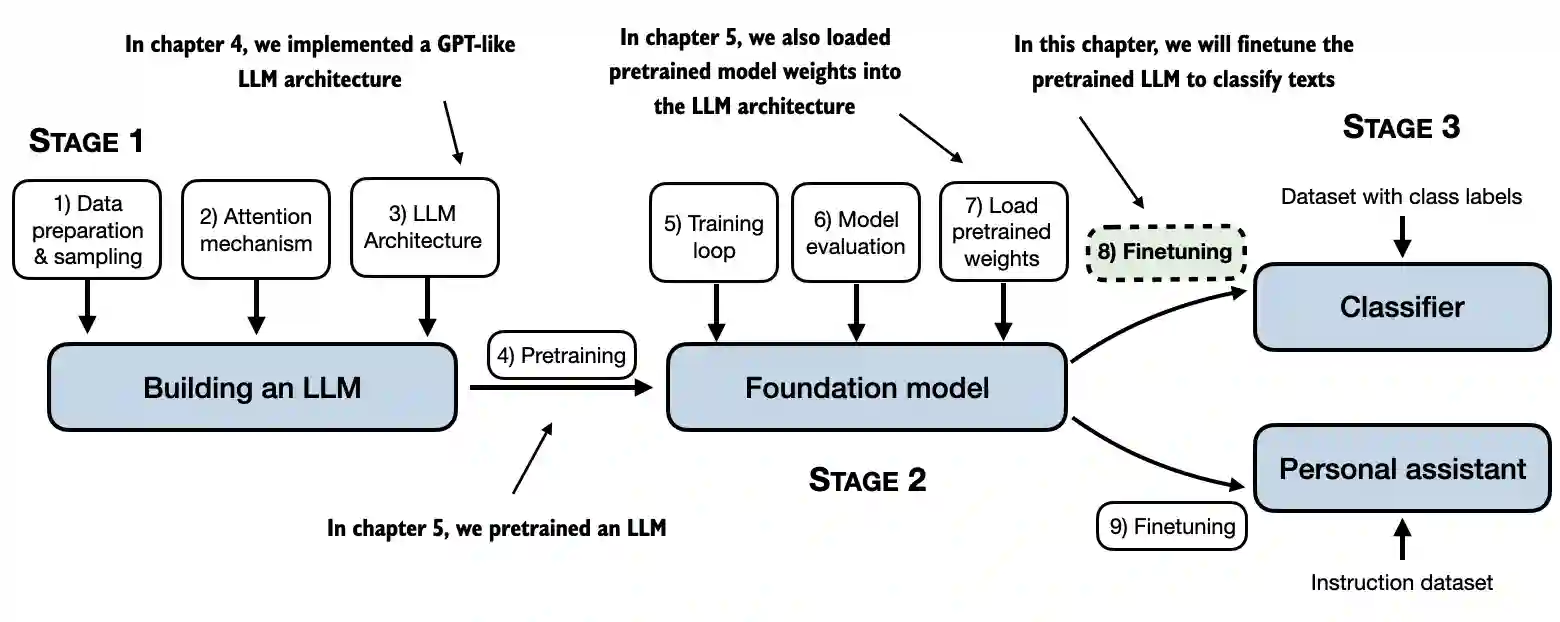
6.1 Different categories of finetuning#
No code in this section
The most common ways to finetune language models are instruction-finetuning and classification finetuning
Instruction-finetuning, depicted below, is the topic of the next chapter

Classification finetuning, the topic of this chapter, is a procedure you may already be familiar with if you have a background in machine learning – it’s similar to training a convolutional network to classify handwritten digits, for example
In classification finetuning, we have a specific number of class labels (for example, “spam” and “not spam”) that the model can output
A classification finetuned model can only predict classes it has seen during training (for example, “spam” or “not spam”), whereas an instruction-finetuned model can usually perform many tasks
We can think of a classification-finetuned model as a very specialized model; in practice, it is much easier to create a specialized model than a generalist model that performs well on many different tasks
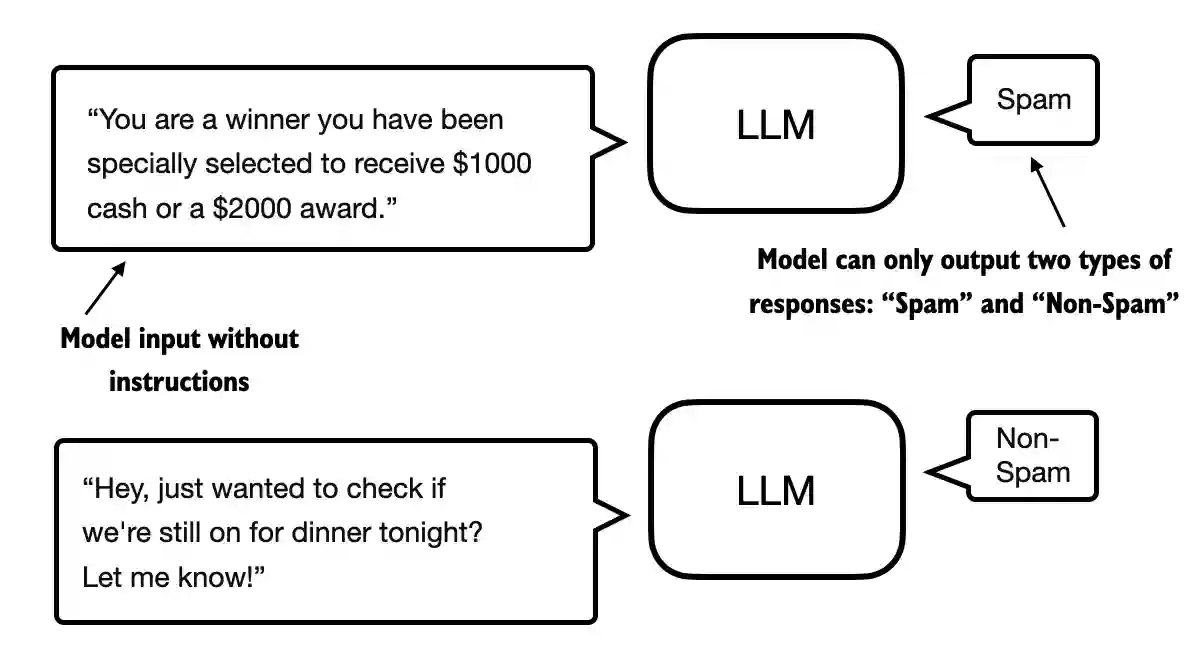
6.2 Preparing the dataset#
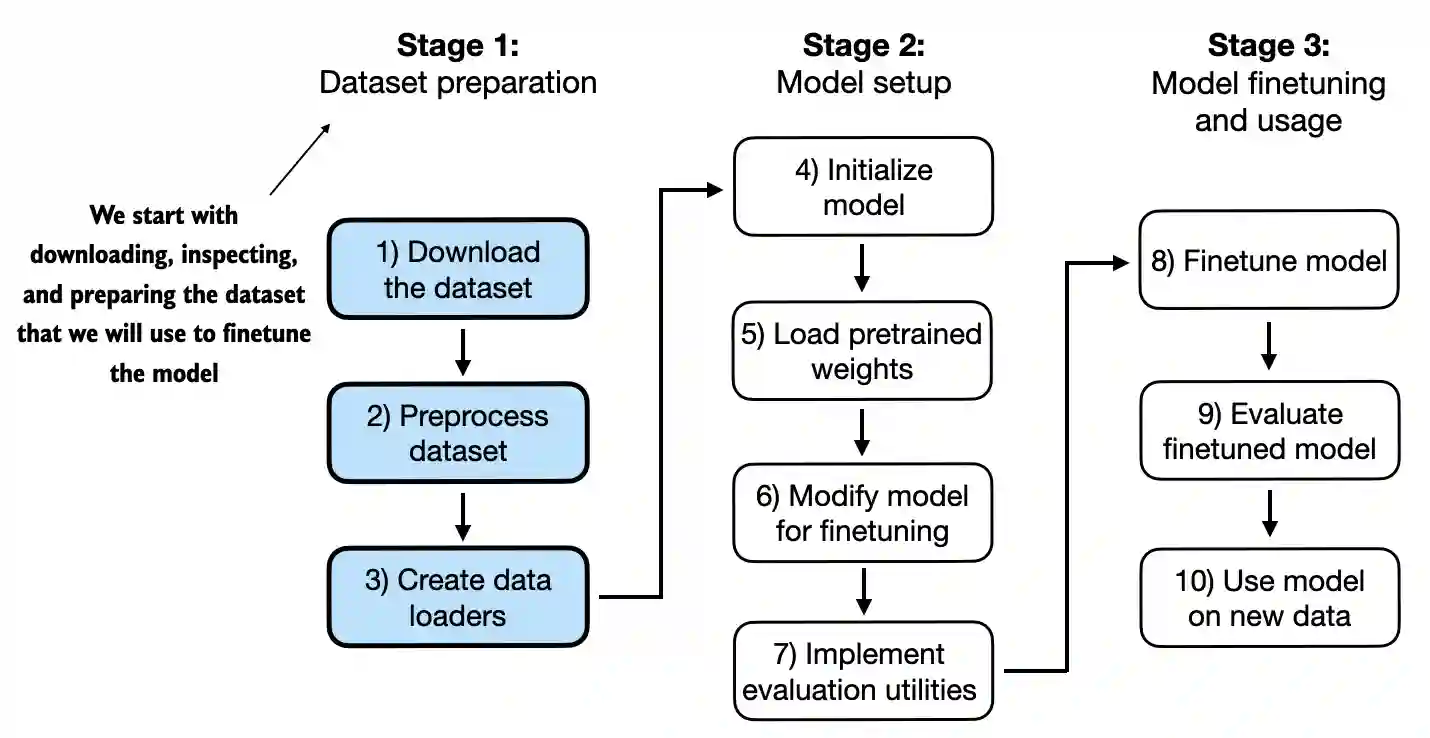
This section prepares the dataset we use for classification finetuning
We use a dataset consisting of spam and non-spam text messages to finetune the LLM to classify them
First, we download and unzip the dataset
import urllib.request
import zipfile
import os
from pathlib import Path
url = "https://archive.ics.uci.edu/static/public/228/sms+spam+collection.zip"
zip_path = "sms_spam_collection.zip"
extracted_path = "sms_spam_collection"
data_file_path = Path(extracted_path) / "SMSSpamCollection.tsv"
def download_and_unzip_spam_data(url, zip_path, extracted_path, data_file_path):
if data_file_path.exists():
print(f"{data_file_path} already exists. Skipping download and extraction.")
return
# Downloading the file
with urllib.request.urlopen(url) as response:
with open(zip_path, "wb") as out_file:
out_file.write(response.read())
# Unzipping the file
with zipfile.ZipFile(zip_path, "r") as zip_ref:
zip_ref.extractall(extracted_path)
# Add .tsv file extension
original_file_path = Path(extracted_path) / "SMSSpamCollection"
os.rename(original_file_path, data_file_path)
print(f"File downloaded and saved as {data_file_path}")
try:
download_and_unzip_spam_data(url, zip_path, extracted_path, data_file_path)
except (urllib.error.HTTPError, urllib.error.URLError, TimeoutError) as e:
print(f"Primary URL failed: {e}. Trying backup URL...")
url = "https://f001.backblazeb2.com/file/LLMs-from-scratch/sms%2Bspam%2Bcollection.zip"
download_and_unzip_spam_data(url, zip_path, extracted_path, data_file_path)
File downloaded and saved as sms_spam_collection/SMSSpamCollection.tsv
The dataset is saved as a tab-separated text file, which we can load into a pandas DataFrame
import pandas as pd
df = pd.read_csv(data_file_path, sep="\t", header=None, names=["Label", "Text"])
df
| Label | Text | |
|---|---|---|
| 0 | ham | Go until jurong point, crazy.. Available only ... |
| 1 | ham | Ok lar... Joking wif u oni... |
| 2 | spam | Free entry in 2 a wkly comp to win FA Cup fina... |
| 3 | ham | U dun say so early hor... U c already then say... |
| 4 | ham | Nah I don't think he goes to usf, he lives aro... |
| ... | ... | ... |
| 5567 | spam | This is the 2nd time we have tried 2 contact u... |
| 5568 | ham | Will ü b going to esplanade fr home? |
| 5569 | ham | Pity, * was in mood for that. So...any other s... |
| 5570 | ham | The guy did some bitching but I acted like i'd... |
| 5571 | ham | Rofl. Its true to its name |
5572 rows × 2 columns
When we check the class distribution, we see that the data contains “ham” (i.e., “not spam”) much more frequently than “spam”
print(df["Label"].value_counts())
Label
ham 4825
spam 747
Name: count, dtype: int64
For simplicity, and because we prefer a small dataset for educational purposes anyway (it will make it possible to finetune the LLM faster), we subsample (undersample) the dataset so that it contains 747 instances from each class
(Next to undersampling, there are several other ways to deal with class balances, but they are out of the scope of a book on LLMs; you can find examples and more information in the
imbalanced-learnuser guide)
def create_balanced_dataset(df):
# Count the instances of "spam"
num_spam = df[df["Label"] == "spam"].shape[0]
# Randomly sample "ham" instances to match the number of "spam" instances
ham_subset = df[df["Label"] == "ham"].sample(num_spam, random_state=123)
# Combine ham "subset" with "spam"
balanced_df = pd.concat([ham_subset, df[df["Label"] == "spam"]])
return balanced_df
balanced_df = create_balanced_dataset(df)
print(balanced_df["Label"].value_counts())
Label
ham 747
spam 747
Name: count, dtype: int64
Next, we change the string class labels “ham” and “spam” into integer class labels 0 and 1:
balanced_df["Label"] = balanced_df["Label"].map({"ham": 0, "spam": 1})
balanced_df
| Label | Text | |
|---|---|---|
| 4307 | 0 | Awww dat is sweet! We can think of something t... |
| 4138 | 0 | Just got to <#> |
| 4831 | 0 | The word "Checkmate" in chess comes from the P... |
| 4461 | 0 | This is wishing you a great day. Moji told me ... |
| 5440 | 0 | Thank you. do you generally date the brothas? |
| ... | ... | ... |
| 5537 | 1 | Want explicit SEX in 30 secs? Ring 02073162414... |
| 5540 | 1 | ASKED 3MOBILE IF 0870 CHATLINES INCLU IN FREE ... |
| 5547 | 1 | Had your contract mobile 11 Mnths? Latest Moto... |
| 5566 | 1 | REMINDER FROM O2: To get 2.50 pounds free call... |
| 5567 | 1 | This is the 2nd time we have tried 2 contact u... |
1494 rows × 2 columns
Let’s now define a function that randomly divides the dataset into training, validation, and test subsets
def random_split(df, train_frac, validation_frac):
# Shuffle the entire DataFrame
df = df.sample(frac=1, random_state=123).reset_index(drop=True)
# Calculate split indices
train_end = int(len(df) * train_frac)
validation_end = train_end + int(len(df) * validation_frac)
# Split the DataFrame
train_df = df[:train_end]
validation_df = df[train_end:validation_end]
test_df = df[validation_end:]
return train_df, validation_df, test_df
train_df, validation_df, test_df = random_split(balanced_df, 0.7, 0.1)
# Test size is implied to be 0.2 as the remainder
train_df.to_csv("train.csv", index=None)
validation_df.to_csv("validation.csv", index=None)
test_df.to_csv("test.csv", index=None)
6.3 Creating data loaders#
Note that the text messages have different lengths; if we want to combine multiple training examples in a batch, we have to either
truncate all messages to the length of the shortest message in the dataset or batch
pad all messages to the length of the longest message in the dataset or batch
We choose option 2 and pad all messages to the longest message in the dataset
For that, we use
<|endoftext|>as a padding token, as discussed in chapter 2
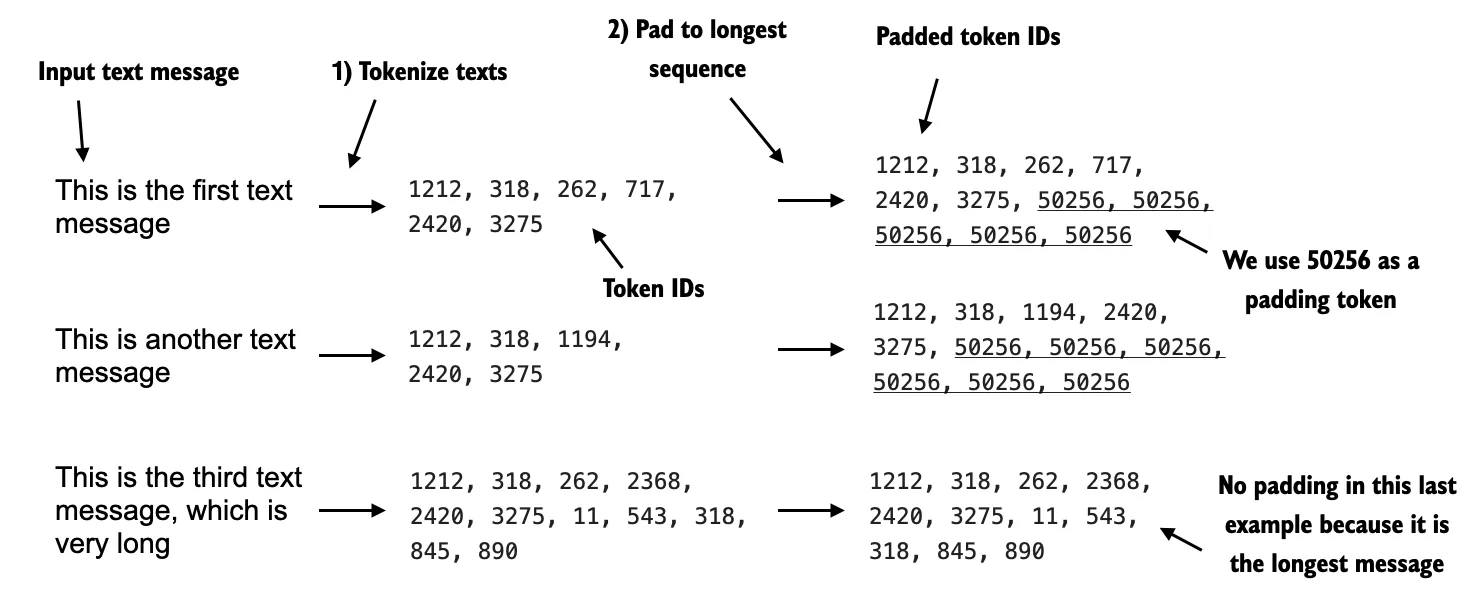
import tiktoken
tokenizer = tiktoken.get_encoding("gpt2")
print(tokenizer.encode("<|endoftext|>", allowed_special={"<|endoftext|>"}))
[50256]
The
SpamDatasetclass below identifies the longest sequence in the training dataset and adds the padding token to the others to match that sequence length
import torch
from torch.utils.data import Dataset
class SpamDataset(Dataset):
def __init__(self, csv_file, tokenizer, max_length=None, pad_token_id=50256):
self.data = pd.read_csv(csv_file)
# Pre-tokenize texts
self.encoded_texts = [
tokenizer.encode(text) for text in self.data["Text"]
]
if max_length is None:
self.max_length = self._longest_encoded_length()
else:
self.max_length = max_length
# Truncate sequences if they are longer than max_length
self.encoded_texts = [
encoded_text[:self.max_length]
for encoded_text in self.encoded_texts
]
# Pad sequences to the longest sequence
self.encoded_texts = [
encoded_text + [pad_token_id] * (self.max_length - len(encoded_text))
for encoded_text in self.encoded_texts
]
def __getitem__(self, index):
encoded = self.encoded_texts[index]
label = self.data.iloc[index]["Label"]
return (
torch.tensor(encoded, dtype=torch.long),
torch.tensor(label, dtype=torch.long)
)
def __len__(self):
return len(self.data)
def _longest_encoded_length(self):
max_length = 0
for encoded_text in self.encoded_texts:
encoded_length = len(encoded_text)
if encoded_length > max_length:
max_length = encoded_length
return max_length
# Note: A more pythonic version to implement this method
# is the following, which is also used in the next chapter:
# return max(len(encoded_text) for encoded_text in self.encoded_texts)
train_dataset = SpamDataset(
csv_file="train.csv",
max_length=None,
tokenizer=tokenizer
)
print(train_dataset.max_length)
120
We also pad the validation and test set to the longest training sequence
Note that validation and test set samples that are longer than the longest training example are being truncated via
encoded_text[:self.max_length]in theSpamDatasetcodeThis behavior is entirely optional, and it would also work well if we set
max_length=Nonein both the validation and test set cases
val_dataset = SpamDataset(
csv_file="validation.csv",
max_length=train_dataset.max_length,
tokenizer=tokenizer
)
test_dataset = SpamDataset(
csv_file="test.csv",
max_length=train_dataset.max_length,
tokenizer=tokenizer
)
Next, we use the dataset to instantiate the data loaders, which is similar to creating the data loaders in previous chapters
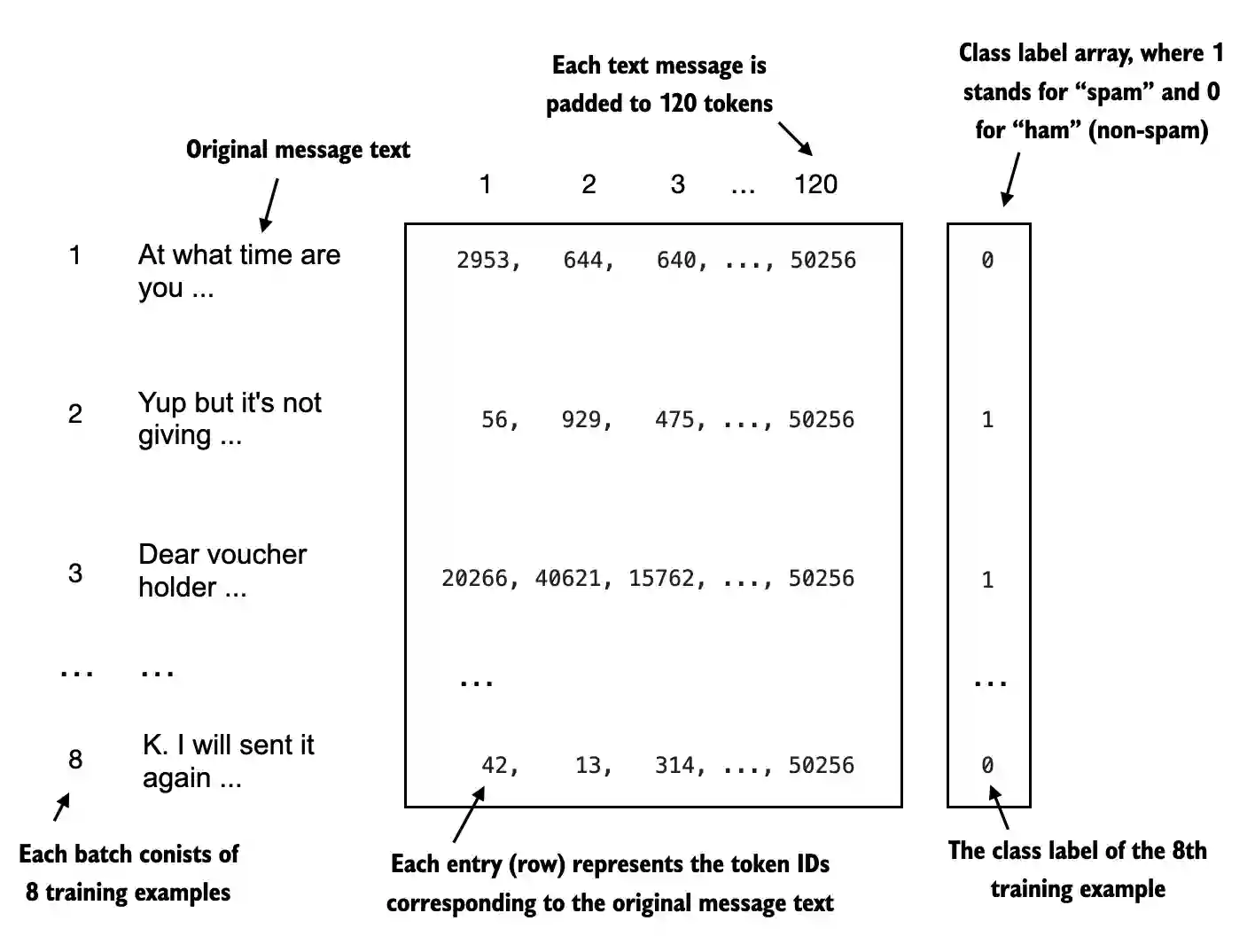
from torch.utils.data import DataLoader
num_workers = 0
batch_size = 8
torch.manual_seed(123)
train_loader = DataLoader(
dataset=train_dataset,
batch_size=batch_size,
shuffle=True,
num_workers=num_workers,
drop_last=True,
)
val_loader = DataLoader(
dataset=val_dataset,
batch_size=batch_size,
num_workers=num_workers,
drop_last=False,
)
test_loader = DataLoader(
dataset=test_dataset,
batch_size=batch_size,
num_workers=num_workers,
drop_last=False,
)
As a verification step, we iterate through the data loaders and ensure that the batches contain 8 training examples each, where each training example consists of 120 tokens
print("Train loader:")
for input_batch, target_batch in train_loader:
pass
print("Input batch dimensions:", input_batch.shape)
print("Label batch dimensions", target_batch.shape)
Train loader:
Input batch dimensions: torch.Size([8, 120])
Label batch dimensions torch.Size([8])
Lastly, let’s print the total number of batches in each dataset
print(f"{len(train_loader)} training batches")
print(f"{len(val_loader)} validation batches")
print(f"{len(test_loader)} test batches")
130 training batches
19 validation batches
38 test batches
6.4 Initializing a model with pretrained weights#
In this section, we initialize the pretrained model we worked with in the previous chapter
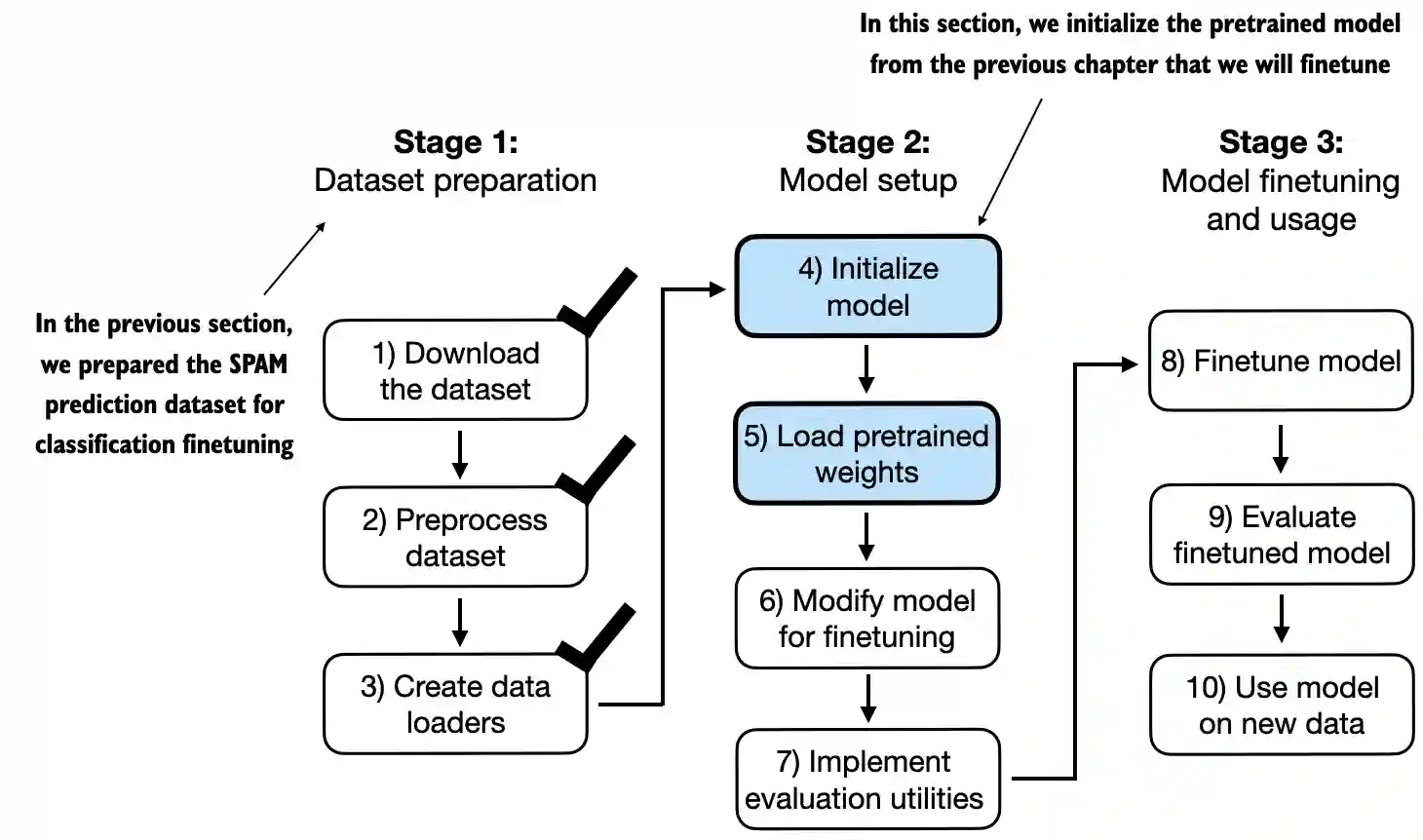
CHOOSE_MODEL = "gpt2-small (124M)"
INPUT_PROMPT = "Every effort moves"
BASE_CONFIG = {
"vocab_size": 50257, # Vocabulary size
"context_length": 1024, # Context length
"drop_rate": 0.0, # Dropout rate
"qkv_bias": True # Query-key-value bias
}
model_configs = {
"gpt2-small (124M)": {"emb_dim": 768, "n_layers": 12, "n_heads": 12},
"gpt2-medium (355M)": {"emb_dim": 1024, "n_layers": 24, "n_heads": 16},
"gpt2-large (774M)": {"emb_dim": 1280, "n_layers": 36, "n_heads": 20},
"gpt2-xl (1558M)": {"emb_dim": 1600, "n_layers": 48, "n_heads": 25},
}
BASE_CONFIG.update(model_configs[CHOOSE_MODEL])
assert train_dataset.max_length <= BASE_CONFIG["context_length"], (
f"Dataset length {train_dataset.max_length} exceeds model's context "
f"length {BASE_CONFIG['context_length']}. Reinitialize data sets with "
f"`max_length={BASE_CONFIG['context_length']}`"
)
from gpt_download import download_and_load_gpt2
from previous_chapters import GPTModel, load_weights_into_gpt
# If the `previous_chapters.py` file is not available locally,
# you can import it from the `llms-from-scratch` PyPI package.
# For details, see: https://github.com/rasbt/LLMs-from-scratch/tree/main/pkg
# E.g.,
# from llms_from_scratch.ch04 import GPTModel
# from llms_from_scratch.ch05 import download_and_load_gpt2, load_weights_into_gpt
model_size = CHOOSE_MODEL.split(" ")[-1].lstrip("(").rstrip(")")
settings, params = download_and_load_gpt2(model_size=model_size, models_dir="gpt2")
model = GPTModel(BASE_CONFIG)
load_weights_into_gpt(model, params)
model.eval();
File already exists and is up-to-date: gpt2/124M/checkpoint
File already exists and is up-to-date: gpt2/124M/encoder.json
File already exists and is up-to-date: gpt2/124M/hparams.json
File already exists and is up-to-date: gpt2/124M/model.ckpt.data-00000-of-00001
File already exists and is up-to-date: gpt2/124M/model.ckpt.index
File already exists and is up-to-date: gpt2/124M/model.ckpt.meta
File already exists and is up-to-date: gpt2/124M/vocab.bpe
To ensure that the model was loaded correctly, let’s double-check that it generates coherent text
from previous_chapters import (
generate_text_simple,
text_to_token_ids,
token_ids_to_text
)
# Alternatively:
# from llms_from_scratch.ch05 import (
# generate_text_simple,
# text_to_token_ids,
# token_ids_to_text
# )
text_1 = "Every effort moves you"
token_ids = generate_text_simple(
model=model,
idx=text_to_token_ids(text_1, tokenizer),
max_new_tokens=15,
context_size=BASE_CONFIG["context_length"]
)
print(token_ids_to_text(token_ids, tokenizer))
Every effort moves you forward.
The first step is to understand the importance of your work
Before we finetune the model as a classifier, let’s see if the model can perhaps already classify spam messages via prompting
text_2 = (
"Is the following text 'spam'? Answer with 'yes' or 'no':"
" 'You are a winner you have been specially"
" selected to receive $1000 cash or a $2000 award.'"
)
token_ids = generate_text_simple(
model=model,
idx=text_to_token_ids(text_2, tokenizer),
max_new_tokens=23,
context_size=BASE_CONFIG["context_length"]
)
print(token_ids_to_text(token_ids, tokenizer))
Is the following text 'spam'? Answer with 'yes' or 'no': 'You are a winner you have been specially selected to receive $1000 cash or a $2000 award.'
The following text 'spam'? Answer with 'yes' or 'no': 'You are a winner
As we can see, the model is not very good at following instructions
This is expected, since it has only been pretrained and not instruction-finetuned (instruction finetuning will be covered in the next chapter)
6.5 Adding a classification head#

In this section, we are modifying the pretrained LLM to make it ready for classification finetuning
Let’s take a look at the model architecture first
print(model)
GPTModel(
(tok_emb): Embedding(50257, 768)
(pos_emb): Embedding(1024, 768)
(drop_emb): Dropout(p=0.0, inplace=False)
(trf_blocks): Sequential(
(0): TransformerBlock(
(att): MultiHeadAttention(
(W_query): Linear(in_features=768, out_features=768, bias=True)
(W_key): Linear(in_features=768, out_features=768, bias=True)
(W_value): Linear(in_features=768, out_features=768, bias=True)
(out_proj): Linear(in_features=768, out_features=768, bias=True)
(dropout): Dropout(p=0.0, inplace=False)
)
(ff): FeedForward(
(layers): Sequential(
(0): Linear(in_features=768, out_features=3072, bias=True)
(1): GELU()
(2): Linear(in_features=3072, out_features=768, bias=True)
)
)
(norm1): LayerNorm()
(norm2): LayerNorm()
(drop_resid): Dropout(p=0.0, inplace=False)
)
(1): TransformerBlock(
(att): MultiHeadAttention(
(W_query): Linear(in_features=768, out_features=768, bias=True)
(W_key): Linear(in_features=768, out_features=768, bias=True)
(W_value): Linear(in_features=768, out_features=768, bias=True)
(out_proj): Linear(in_features=768, out_features=768, bias=True)
(dropout): Dropout(p=0.0, inplace=False)
)
(ff): FeedForward(
(layers): Sequential(
(0): Linear(in_features=768, out_features=3072, bias=True)
(1): GELU()
(2): Linear(in_features=3072, out_features=768, bias=True)
)
)
(norm1): LayerNorm()
(norm2): LayerNorm()
(drop_resid): Dropout(p=0.0, inplace=False)
)
(2): TransformerBlock(
(att): MultiHeadAttention(
(W_query): Linear(in_features=768, out_features=768, bias=True)
(W_key): Linear(in_features=768, out_features=768, bias=True)
(W_value): Linear(in_features=768, out_features=768, bias=True)
(out_proj): Linear(in_features=768, out_features=768, bias=True)
(dropout): Dropout(p=0.0, inplace=False)
)
(ff): FeedForward(
(layers): Sequential(
(0): Linear(in_features=768, out_features=3072, bias=True)
(1): GELU()
(2): Linear(in_features=3072, out_features=768, bias=True)
)
)
(norm1): LayerNorm()
(norm2): LayerNorm()
(drop_resid): Dropout(p=0.0, inplace=False)
)
(3): TransformerBlock(
(att): MultiHeadAttention(
(W_query): Linear(in_features=768, out_features=768, bias=True)
(W_key): Linear(in_features=768, out_features=768, bias=True)
(W_value): Linear(in_features=768, out_features=768, bias=True)
(out_proj): Linear(in_features=768, out_features=768, bias=True)
(dropout): Dropout(p=0.0, inplace=False)
)
(ff): FeedForward(
(layers): Sequential(
(0): Linear(in_features=768, out_features=3072, bias=True)
(1): GELU()
(2): Linear(in_features=3072, out_features=768, bias=True)
)
)
(norm1): LayerNorm()
(norm2): LayerNorm()
(drop_resid): Dropout(p=0.0, inplace=False)
)
(4): TransformerBlock(
(att): MultiHeadAttention(
(W_query): Linear(in_features=768, out_features=768, bias=True)
(W_key): Linear(in_features=768, out_features=768, bias=True)
(W_value): Linear(in_features=768, out_features=768, bias=True)
(out_proj): Linear(in_features=768, out_features=768, bias=True)
(dropout): Dropout(p=0.0, inplace=False)
)
(ff): FeedForward(
(layers): Sequential(
(0): Linear(in_features=768, out_features=3072, bias=True)
(1): GELU()
(2): Linear(in_features=3072, out_features=768, bias=True)
)
)
(norm1): LayerNorm()
(norm2): LayerNorm()
(drop_resid): Dropout(p=0.0, inplace=False)
)
(5): TransformerBlock(
(att): MultiHeadAttention(
(W_query): Linear(in_features=768, out_features=768, bias=True)
(W_key): Linear(in_features=768, out_features=768, bias=True)
(W_value): Linear(in_features=768, out_features=768, bias=True)
(out_proj): Linear(in_features=768, out_features=768, bias=True)
(dropout): Dropout(p=0.0, inplace=False)
)
(ff): FeedForward(
(layers): Sequential(
(0): Linear(in_features=768, out_features=3072, bias=True)
(1): GELU()
(2): Linear(in_features=3072, out_features=768, bias=True)
)
)
(norm1): LayerNorm()
(norm2): LayerNorm()
(drop_resid): Dropout(p=0.0, inplace=False)
)
(6): TransformerBlock(
(att): MultiHeadAttention(
(W_query): Linear(in_features=768, out_features=768, bias=True)
(W_key): Linear(in_features=768, out_features=768, bias=True)
(W_value): Linear(in_features=768, out_features=768, bias=True)
(out_proj): Linear(in_features=768, out_features=768, bias=True)
(dropout): Dropout(p=0.0, inplace=False)
)
(ff): FeedForward(
(layers): Sequential(
(0): Linear(in_features=768, out_features=3072, bias=True)
(1): GELU()
(2): Linear(in_features=3072, out_features=768, bias=True)
)
)
(norm1): LayerNorm()
(norm2): LayerNorm()
(drop_resid): Dropout(p=0.0, inplace=False)
)
(7): TransformerBlock(
(att): MultiHeadAttention(
(W_query): Linear(in_features=768, out_features=768, bias=True)
(W_key): Linear(in_features=768, out_features=768, bias=True)
(W_value): Linear(in_features=768, out_features=768, bias=True)
(out_proj): Linear(in_features=768, out_features=768, bias=True)
(dropout): Dropout(p=0.0, inplace=False)
)
(ff): FeedForward(
(layers): Sequential(
(0): Linear(in_features=768, out_features=3072, bias=True)
(1): GELU()
(2): Linear(in_features=3072, out_features=768, bias=True)
)
)
(norm1): LayerNorm()
(norm2): LayerNorm()
(drop_resid): Dropout(p=0.0, inplace=False)
)
(8): TransformerBlock(
(att): MultiHeadAttention(
(W_query): Linear(in_features=768, out_features=768, bias=True)
(W_key): Linear(in_features=768, out_features=768, bias=True)
(W_value): Linear(in_features=768, out_features=768, bias=True)
(out_proj): Linear(in_features=768, out_features=768, bias=True)
(dropout): Dropout(p=0.0, inplace=False)
)
(ff): FeedForward(
(layers): Sequential(
(0): Linear(in_features=768, out_features=3072, bias=True)
(1): GELU()
(2): Linear(in_features=3072, out_features=768, bias=True)
)
)
(norm1): LayerNorm()
(norm2): LayerNorm()
(drop_resid): Dropout(p=0.0, inplace=False)
)
(9): TransformerBlock(
(att): MultiHeadAttention(
(W_query): Linear(in_features=768, out_features=768, bias=True)
(W_key): Linear(in_features=768, out_features=768, bias=True)
(W_value): Linear(in_features=768, out_features=768, bias=True)
(out_proj): Linear(in_features=768, out_features=768, bias=True)
(dropout): Dropout(p=0.0, inplace=False)
)
(ff): FeedForward(
(layers): Sequential(
(0): Linear(in_features=768, out_features=3072, bias=True)
(1): GELU()
(2): Linear(in_features=3072, out_features=768, bias=True)
)
)
(norm1): LayerNorm()
(norm2): LayerNorm()
(drop_resid): Dropout(p=0.0, inplace=False)
)
(10): TransformerBlock(
(att): MultiHeadAttention(
(W_query): Linear(in_features=768, out_features=768, bias=True)
(W_key): Linear(in_features=768, out_features=768, bias=True)
(W_value): Linear(in_features=768, out_features=768, bias=True)
(out_proj): Linear(in_features=768, out_features=768, bias=True)
(dropout): Dropout(p=0.0, inplace=False)
)
(ff): FeedForward(
(layers): Sequential(
(0): Linear(in_features=768, out_features=3072, bias=True)
(1): GELU()
(2): Linear(in_features=3072, out_features=768, bias=True)
)
)
(norm1): LayerNorm()
(norm2): LayerNorm()
(drop_resid): Dropout(p=0.0, inplace=False)
)
(11): TransformerBlock(
(att): MultiHeadAttention(
(W_query): Linear(in_features=768, out_features=768, bias=True)
(W_key): Linear(in_features=768, out_features=768, bias=True)
(W_value): Linear(in_features=768, out_features=768, bias=True)
(out_proj): Linear(in_features=768, out_features=768, bias=True)
(dropout): Dropout(p=0.0, inplace=False)
)
(ff): FeedForward(
(layers): Sequential(
(0): Linear(in_features=768, out_features=3072, bias=True)
(1): GELU()
(2): Linear(in_features=3072, out_features=768, bias=True)
)
)
(norm1): LayerNorm()
(norm2): LayerNorm()
(drop_resid): Dropout(p=0.0, inplace=False)
)
)
(final_norm): LayerNorm()
(out_head): Linear(in_features=768, out_features=50257, bias=False)
)
Above, we can see the architecture we implemented in chapter 4 neatly laid out
The goal is to replace and finetune the output layer
To achieve this, we first freeze the model, meaning that we make all layers non-trainable
for param in model.parameters():
param.requires_grad = False
Then, we replace the output layer (
model.out_head), which originally maps the layer inputs to 50,257 dimensions (the size of the vocabulary)Since we finetune the model for binary classification (predicting 2 classes, “spam” and “not spam”), we can replace the output layer as shown below, which will be trainable by default
Note that we use
BASE_CONFIG["emb_dim"](which is equal to 768 in the"gpt2-small (124M)"model) to keep the code below more general
torch.manual_seed(123)
num_classes = 2
model.out_head = torch.nn.Linear(in_features=BASE_CONFIG["emb_dim"], out_features=num_classes)
Technically, it’s sufficient to only train the output layer
However, as I found in Finetuning Large Language Models, experiments show that finetuning additional layers can noticeably improve the performance
So, we are also making the last transformer block and the final
LayerNormmodule connecting the last transformer block to the output layer trainable

for param in model.trf_blocks[-1].parameters():
param.requires_grad = True
for param in model.final_norm.parameters():
param.requires_grad = True
We can still use this model similar to before in previous chapters
For example, let’s feed it some text input
inputs = tokenizer.encode("Do you have time")
inputs = torch.tensor(inputs).unsqueeze(0)
print("Inputs:", inputs)
print("Inputs dimensions:", inputs.shape) # shape: (batch_size, num_tokens)
Inputs: tensor([[5211, 345, 423, 640]])
Inputs dimensions: torch.Size([1, 4])
What’s different compared to previous chapters is that it now has two output dimensions instead of 50,257
with torch.no_grad():
outputs = model(inputs)
print("Outputs:\n", outputs)
print("Outputs dimensions:", outputs.shape) # shape: (batch_size, num_tokens, num_classes)
Outputs:
tensor([[[-1.5854, 0.9904],
[-3.7235, 7.4548],
[-2.2661, 6.6049],
[-3.5983, 3.9902]]])
Outputs dimensions: torch.Size([1, 4, 2])
As discussed in previous chapters, for each input token, there’s one output vector
Since we fed the model a text sample with 4 input tokens, the output consists of 4 2-dimensional output vectors above
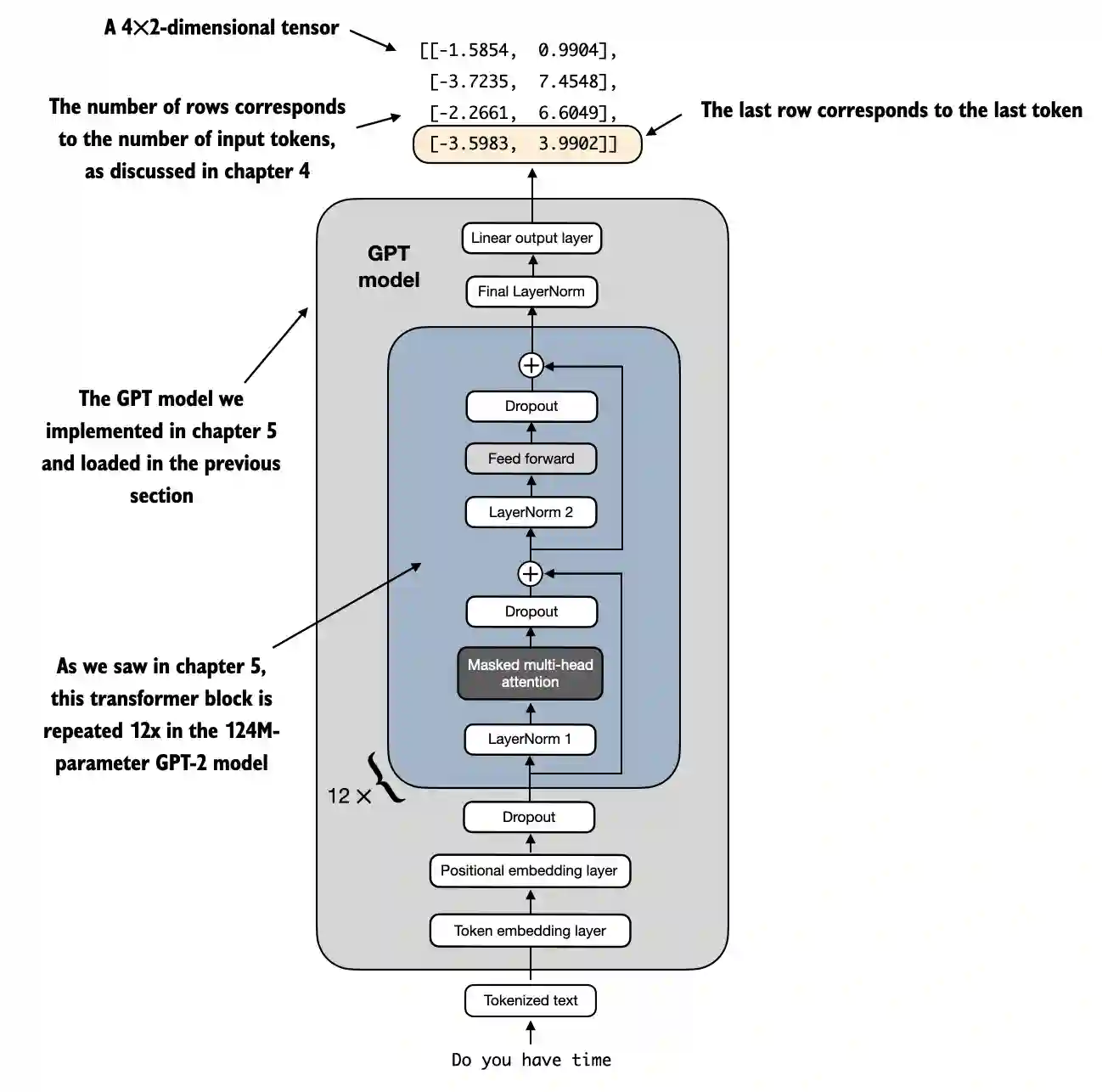
In chapter 3, we discussed the attention mechanism, which connects each input token to each other input token
In chapter 3, we then also introduced the causal attention mask that is used in GPT-like models; this causal mask lets a current token only attend to the current and previous token positions
Based on this causal attention mechanism, the 4th (last) token contains the most information among all tokens because it’s the only token that includes information about all other tokens
Hence, we are particularly interested in this last token, which we will finetune for the spam classification task
print("Last output token:", outputs[:, -1, :])
Last output token: tensor([[-3.5983, 3.9902]])
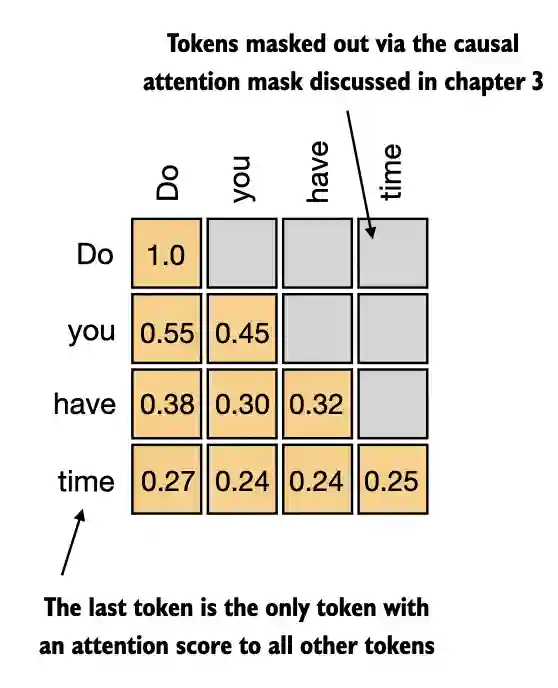
6.6 Calculating the classification loss and accuracy#
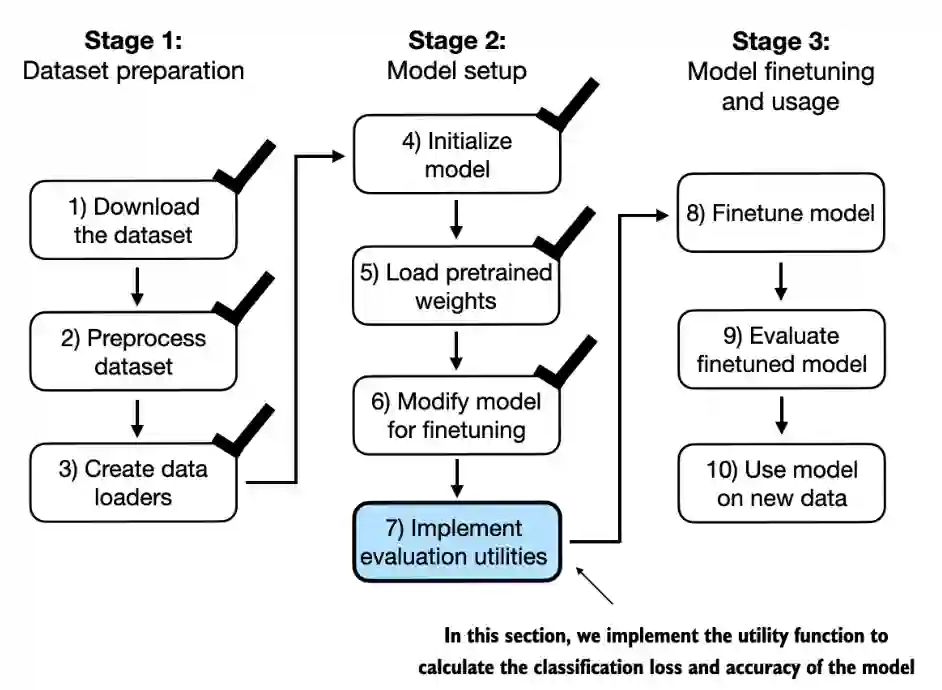
Before explaining the loss calculation, let’s have a brief look at how the model outputs are turned into class labels
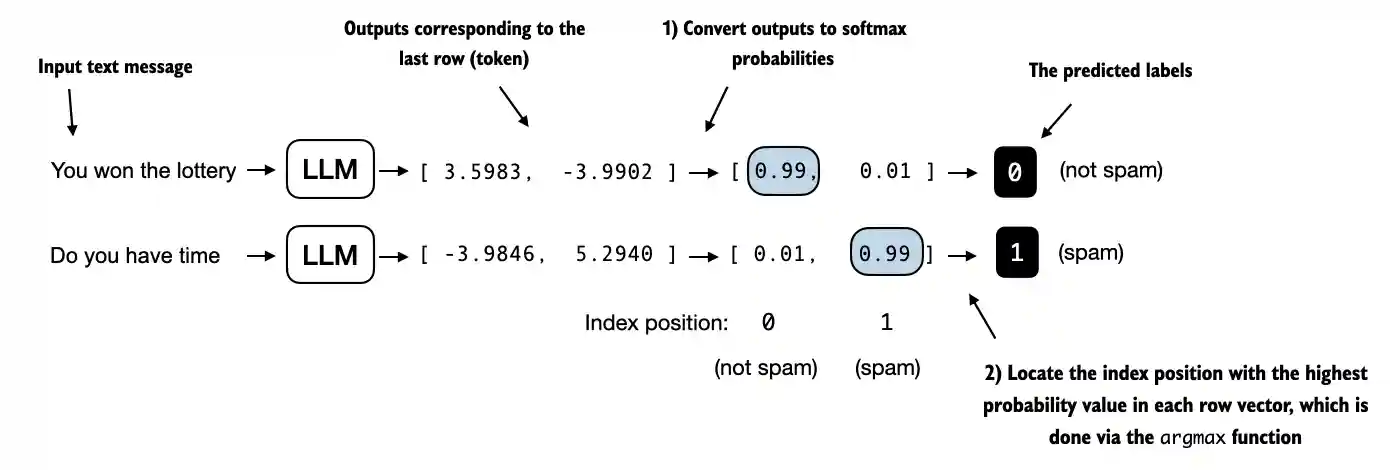
print("Last output token:", outputs[:, -1, :])
Last output token: tensor([[-3.5983, 3.9902]])
Similar to chapter 5, we convert the outputs (logits) into probability scores via the
softmaxfunction and then obtain the index position of the largest probability value via theargmaxfunction
probas = torch.softmax(outputs[:, -1, :], dim=-1)
label = torch.argmax(probas)
print("Class label:", label.item())
Class label: 1
Note that the softmax function is optional here, as explained in chapter 5, because the largest outputs correspond to the largest probability scores
logits = outputs[:, -1, :]
label = torch.argmax(logits)
print("Class label:", label.item())
Class label: 1
We can apply this concept to calculate the so-called classification accuracy, which computes the percentage of correct predictions in a given dataset
To calculate the classification accuracy, we can apply the preceding
argmax-based prediction code to all examples in a dataset and calculate the fraction of correct predictions as follows:
def calc_accuracy_loader(data_loader, model, device, num_batches=None):
model.eval()
correct_predictions, num_examples = 0, 0
if num_batches is None:
num_batches = len(data_loader)
else:
num_batches = min(num_batches, len(data_loader))
for i, (input_batch, target_batch) in enumerate(data_loader):
if i < num_batches:
input_batch, target_batch = input_batch.to(device), target_batch.to(device)
with torch.no_grad():
logits = model(input_batch)[:, -1, :] # Logits of last output token
predicted_labels = torch.argmax(logits, dim=-1)
num_examples += predicted_labels.shape[0]
correct_predictions += (predicted_labels == target_batch).sum().item()
else:
break
return correct_predictions / num_examples
Let’s apply the function to calculate the classification accuracies for the different datasets:
device = torch.device("cuda" if torch.cuda.is_available() else "cpu")
# Note:
# Uncommenting the following lines will allow the code to run on Apple Silicon chips, if applicable,
# which is approximately 2x faster than on an Apple CPU (as measured on an M3 MacBook Air).
# As of this writing, in PyTorch 2.4, the results obtained via CPU and MPS were identical.
# However, in earlier versions of PyTorch, you may observe different results when using MPS.
#if torch.cuda.is_available():
# device = torch.device("cuda")
#elif torch.backends.mps.is_available():
# device = torch.device("mps")
#else:
# device = torch.device("cpu")
#print(f"Running on {device} device.")
model.to(device) # no assignment model = model.to(device) necessary for nn.Module classes
torch.manual_seed(123) # For reproducibility due to the shuffling in the training data loader
train_accuracy = calc_accuracy_loader(train_loader, model, device, num_batches=10)
val_accuracy = calc_accuracy_loader(val_loader, model, device, num_batches=10)
test_accuracy = calc_accuracy_loader(test_loader, model, device, num_batches=10)
print(f"Training accuracy: {train_accuracy*100:.2f}%")
print(f"Validation accuracy: {val_accuracy*100:.2f}%")
print(f"Test accuracy: {test_accuracy*100:.2f}%")
Training accuracy: 46.25%
Validation accuracy: 45.00%
Test accuracy: 48.75%
As we can see, the prediction accuracies are not very good, since we haven’t finetuned the model, yet
Before we can start finetuning (/training), we first have to define the loss function we want to optimize during training
The goal is to maximize the spam classification accuracy of the model; however, classification accuracy is not a differentiable function
Hence, instead, we minimize the cross-entropy loss as a proxy for maximizing the classification accuracy (you can learn more about this topic in lecture 8 of my freely available Introduction to Deep Learning class)
The
calc_loss_batchfunction is the same here as in chapter 5, except that we are only interested in optimizing the last tokenmodel(input_batch)[:, -1, :]instead of all tokensmodel(input_batch)
def calc_loss_batch(input_batch, target_batch, model, device):
input_batch, target_batch = input_batch.to(device), target_batch.to(device)
logits = model(input_batch)[:, -1, :] # Logits of last output token
loss = torch.nn.functional.cross_entropy(logits, target_batch)
return loss
The calc_loss_loader is exactly the same as in chapter 5
# Same as in chapter 5
def calc_loss_loader(data_loader, model, device, num_batches=None):
total_loss = 0.
if len(data_loader) == 0:
return float("nan")
elif num_batches is None:
num_batches = len(data_loader)
else:
# Reduce the number of batches to match the total number of batches in the data loader
# if num_batches exceeds the number of batches in the data loader
num_batches = min(num_batches, len(data_loader))
for i, (input_batch, target_batch) in enumerate(data_loader):
if i < num_batches:
loss = calc_loss_batch(input_batch, target_batch, model, device)
total_loss += loss.item()
else:
break
return total_loss / num_batches
Using the
calc_closs_loader, we compute the initial training, validation, and test set losses before we start training
with torch.no_grad(): # Disable gradient tracking for efficiency because we are not training, yet
train_loss = calc_loss_loader(train_loader, model, device, num_batches=5)
val_loss = calc_loss_loader(val_loader, model, device, num_batches=5)
test_loss = calc_loss_loader(test_loader, model, device, num_batches=5)
print(f"Training loss: {train_loss:.3f}")
print(f"Validation loss: {val_loss:.3f}")
print(f"Test loss: {test_loss:.3f}")
Training loss: 2.453
Validation loss: 2.583
Test loss: 2.322
In the next section, we train the model to improve the loss values and consequently the classification accuracy
6.7 Finetuning the model on supervised data#
In this section, we define and use the training function to improve the classification accuracy of the model
The
train_classifier_simplefunction below is practically the same as thetrain_model_simplefunction we used for pretraining the model in chapter 5The only two differences are that we now
track the number of training examples seen (
examples_seen) instead of the number of tokens seencalculate the accuracy after each epoch instead of printing a sample text after each epoch
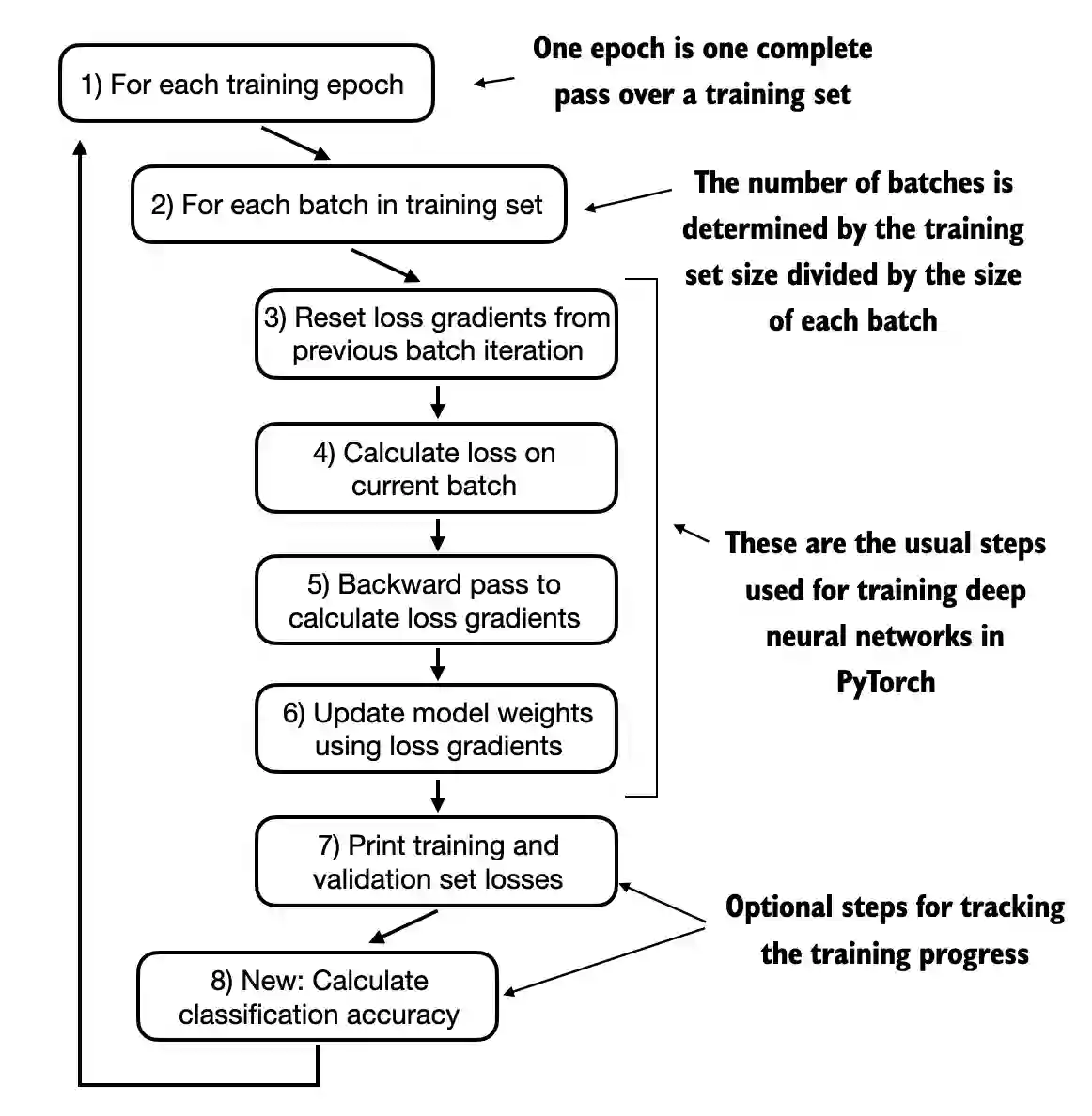
# Overall the same as `train_model_simple` in chapter 5
def train_classifier_simple(model, train_loader, val_loader, optimizer, device, num_epochs,
eval_freq, eval_iter):
# Initialize lists to track losses and examples seen
train_losses, val_losses, train_accs, val_accs = [], [], [], []
examples_seen, global_step = 0, -1
# Main training loop
for epoch in range(num_epochs):
model.train() # Set model to training mode
for input_batch, target_batch in train_loader:
optimizer.zero_grad() # Reset loss gradients from previous batch iteration
loss = calc_loss_batch(input_batch, target_batch, model, device)
loss.backward() # Calculate loss gradients
optimizer.step() # Update model weights using loss gradients
examples_seen += input_batch.shape[0] # New: track examples instead of tokens
global_step += 1
# Optional evaluation step
if global_step % eval_freq == 0:
train_loss, val_loss = evaluate_model(
model, train_loader, val_loader, device, eval_iter)
train_losses.append(train_loss)
val_losses.append(val_loss)
print(f"Ep {epoch+1} (Step {global_step:06d}): "
f"Train loss {train_loss:.3f}, Val loss {val_loss:.3f}")
# Calculate accuracy after each epoch
train_accuracy = calc_accuracy_loader(train_loader, model, device, num_batches=eval_iter)
val_accuracy = calc_accuracy_loader(val_loader, model, device, num_batches=eval_iter)
print(f"Training accuracy: {train_accuracy*100:.2f}% | ", end="")
print(f"Validation accuracy: {val_accuracy*100:.2f}%")
train_accs.append(train_accuracy)
val_accs.append(val_accuracy)
return train_losses, val_losses, train_accs, val_accs, examples_seen
The
evaluate_modelfunction used in thetrain_classifier_simpleis the same as the one we used in chapter 5
# Same as chapter 5
def evaluate_model(model, train_loader, val_loader, device, eval_iter):
model.eval()
with torch.no_grad():
train_loss = calc_loss_loader(train_loader, model, device, num_batches=eval_iter)
val_loss = calc_loss_loader(val_loader, model, device, num_batches=eval_iter)
model.train()
return train_loss, val_loss
The training takes about 5 minutes on a M3 MacBook Air laptop computer and less than half a minute on a V100 or A100 GPU
import time
start_time = time.time()
torch.manual_seed(123)
optimizer = torch.optim.AdamW(model.parameters(), lr=5e-5, weight_decay=0.1)
num_epochs = 5
train_losses, val_losses, train_accs, val_accs, examples_seen = train_classifier_simple(
model, train_loader, val_loader, optimizer, device,
num_epochs=num_epochs, eval_freq=50, eval_iter=5,
)
end_time = time.time()
execution_time_minutes = (end_time - start_time) / 60
print(f"Training completed in {execution_time_minutes:.2f} minutes.")
Ep 1 (Step 000000): Train loss 2.153, Val loss 2.392
Ep 1 (Step 000050): Train loss 0.617, Val loss 0.637
Ep 1 (Step 000100): Train loss 0.523, Val loss 0.557
Training accuracy: 70.00% | Validation accuracy: 72.50%
Ep 2 (Step 000150): Train loss 0.561, Val loss 0.489
Ep 2 (Step 000200): Train loss 0.419, Val loss 0.397
Ep 2 (Step 000250): Train loss 0.409, Val loss 0.353
Training accuracy: 82.50% | Validation accuracy: 85.00%
Ep 3 (Step 000300): Train loss 0.333, Val loss 0.320
Ep 3 (Step 000350): Train loss 0.340, Val loss 0.306
Training accuracy: 90.00% | Validation accuracy: 90.00%
Ep 4 (Step 000400): Train loss 0.136, Val loss 0.200
Ep 4 (Step 000450): Train loss 0.153, Val loss 0.132
Ep 4 (Step 000500): Train loss 0.222, Val loss 0.137
Training accuracy: 100.00% | Validation accuracy: 97.50%
Ep 5 (Step 000550): Train loss 0.207, Val loss 0.143
Ep 5 (Step 000600): Train loss 0.083, Val loss 0.074
Training accuracy: 100.00% | Validation accuracy: 97.50%
Training completed in 5.31 minutes.
Similar to chapter 5, we use matplotlib to plot the loss function for the training and validation set
import matplotlib.pyplot as plt
def plot_values(epochs_seen, examples_seen, train_values, val_values, label="loss"):
fig, ax1 = plt.subplots(figsize=(5, 3))
# Plot training and validation loss against epochs
ax1.plot(epochs_seen, train_values, label=f"Training {label}")
ax1.plot(epochs_seen, val_values, linestyle="-.", label=f"Validation {label}")
ax1.set_xlabel("Epochs")
ax1.set_ylabel(label.capitalize())
ax1.legend()
# Create a second x-axis for examples seen
ax2 = ax1.twiny() # Create a second x-axis that shares the same y-axis
ax2.plot(examples_seen, train_values, alpha=0) # Invisible plot for aligning ticks
ax2.set_xlabel("Examples seen")
fig.tight_layout() # Adjust layout to make room
plt.savefig(f"{label}-plot.pdf")
plt.show()
epochs_tensor = torch.linspace(0, num_epochs, len(train_losses))
examples_seen_tensor = torch.linspace(0, examples_seen, len(train_losses))
plot_values(epochs_tensor, examples_seen_tensor, train_losses, val_losses)
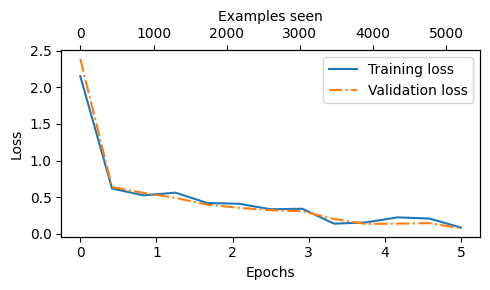
Above, based on the downward slope, we see that the model learns well
Furthermore, the fact that the training and validation loss are very close indicates that the model does not tend to overfit the training data
Similarly, we can plot the accuracy below
epochs_tensor = torch.linspace(0, num_epochs, len(train_accs))
examples_seen_tensor = torch.linspace(0, examples_seen, len(train_accs))
plot_values(epochs_tensor, examples_seen_tensor, train_accs, val_accs, label="accuracy")

Based on the accuracy plot above, we can see that the model achieves a relatively high training and validation accuracy after epochs 4 and 5
However, we have to keep in mind that we specified
eval_iter=5in the training function earlier, which means that we only estimated the training and validation set performancesWe can compute the training, validation, and test set performances over the complete dataset as follows below
train_accuracy = calc_accuracy_loader(train_loader, model, device)
val_accuracy = calc_accuracy_loader(val_loader, model, device)
test_accuracy = calc_accuracy_loader(test_loader, model, device)
print(f"Training accuracy: {train_accuracy*100:.2f}%")
print(f"Validation accuracy: {val_accuracy*100:.2f}%")
print(f"Test accuracy: {test_accuracy*100:.2f}%")
Training accuracy: 97.21%
Validation accuracy: 97.32%
Test accuracy: 95.67%
We can see that the training and validation set performances are practically identical
However, based on the slightly lower test set performance, we can see that the model overfits the training data to a very small degree, as well as the validation data that has been used for tweaking some of the hyperparameters, such as the learning rate
This is normal, however, and this gap could potentially be further reduced by increasing the model’s dropout rate (
drop_rate) or theweight_decayin the optimizer setting
6.8 Using the LLM as a spam classifier#
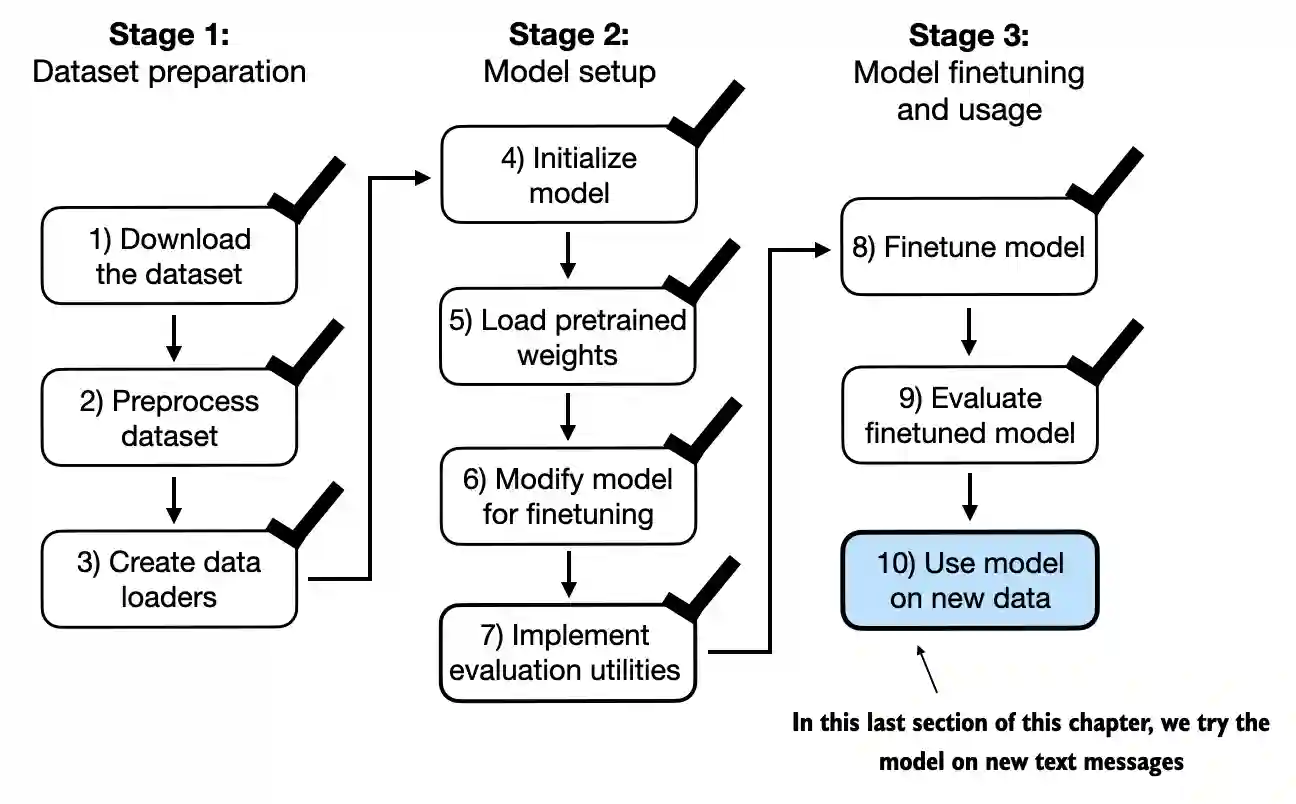
Finally, let’s use the finetuned GPT model in action
The
classify_reviewfunction below implements the data preprocessing steps similar to theSpamDatasetwe implemented earlierThen, the function returns the predicted integer class label from the model and returns the corresponding class name
def classify_review(text, model, tokenizer, device, max_length=None, pad_token_id=50256):
model.eval()
# Prepare inputs to the model
input_ids = tokenizer.encode(text)
supported_context_length = model.pos_emb.weight.shape[0]
# Note: In the book, this was originally written as pos_emb.weight.shape[1] by mistake
# It didn't break the code but would have caused unnecessary truncation (to 768 instead of 1024)
# Truncate sequences if they too long
input_ids = input_ids[:min(max_length, supported_context_length)]
# Pad sequences to the longest sequence
input_ids += [pad_token_id] * (max_length - len(input_ids))
input_tensor = torch.tensor(input_ids, device=device).unsqueeze(0) # add batch dimension
# Model inference
with torch.no_grad():
logits = model(input_tensor)[:, -1, :] # Logits of the last output token
predicted_label = torch.argmax(logits, dim=-1).item()
# Return the classified result
return "spam" if predicted_label == 1 else "not spam"
Let’s try it out on a few examples below
text_1 = (
"You are a winner you have been specially"
" selected to receive $1000 cash or a $2000 award."
)
print(classify_review(
text_1, model, tokenizer, device, max_length=train_dataset.max_length
))
spam
text_2 = (
"Hey, just wanted to check if we're still on"
" for dinner tonight? Let me know!"
)
print(classify_review(
text_2, model, tokenizer, device, max_length=train_dataset.max_length
))
not spam
Finally, let’s save the model in case we want to reuse the model later without having to train it again
torch.save(model.state_dict(), "review_classifier.pth")
Then, in a new session, we could load the model as follows
model_state_dict = torch.load("review_classifier.pth", map_location=device, weights_only=True)
model.load_state_dict(model_state_dict)
<All keys matched successfully>
Summary and takeaways#
See the ./gpt_class_finetune.py script, a self-contained script for classification finetuning
You can find the exercise solutions in ./exercise-solutions.ipynb
In addition, interested readers can find an introduction to parameter-efficient training with low-rank adaptation (LoRA) in appendix E

